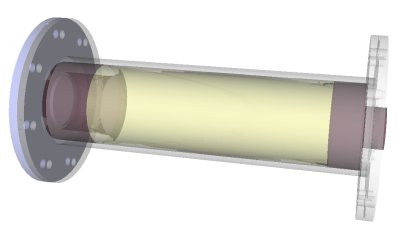GOX/Paraffin Project Outline

Since the Portland State Aerospace Society formed in 1997 we have known that eventually we would need some form of thrust vector control on our vehicles to achieve an ‘actively controlled’ rocket. This would most likely involve a bi-propellant or hybrid motor. The ability to throttle and steer a rocket is impractical or impossible with solid propellant technology.
Up to this point the group’s efforts have focused on producing a vehicle, avionics system and infrastructure to allow us start the process of developing an actively guided sounding rocket. We have made significant progress in these areas and it was decided that it is now time to start parallel tasking the development of a propulsion system capable of active guidance. Thereby replacing our solid propellant motors as the principle means of propulsion.
In July of 2003 the first ‘propulsion team’ meeting was held to start down this path. This is a long-term project. As with all the systems the PSAS has developed, we will approach this with a careful and incremental process relying on our engineering skills and a scientific method.
Why build a gaseous oxygen/paraffin hybrid rocket motor??
The purpose for building a gaseous oxygen/paraffin hybrid rocket motor are:
1) Evaluate paraffin as a potential fuel for a liquid oxygen/ paraffin flight motor for future use in PSAS sounding rockets.
2) To learn about and gain experience in designing and building hybrid rocket motors by starting small.
3) Develop interest in rocket motor design and construction and recruit people to work on a future liquid motor.
Why Hybrid and not bi-propellant or solid motors??
The reason we have choose hybrid motor technology over traditional solid or liquid motor design is:
1) Safety - The two-phase components of a liquid oxidizer and a solid fuel present less of an explosion hazard than solid propellant or bi-propellant motors.
2) Controllability - A hybrid motor may be shut down and restarted as well as throttled. This cannot be done with traditional solid motors.
3) Simplicity - A solid fuel grain and pressure fed liquid oxidizer system is much easier to design in regards to the plumbing and injection requirements of a bi-propellant motor.
4) Manufacturability - Hybrid can be less complex to fabricate the combustion chamber and injectors over bi-propellant motors. The fuel and oxidizer combination in most hybrids do not require special permits and storage requirements like most solid propellant motors.
What’s with this candle wax fuel??
Our choice of paraffin as a fuel is because:
1) Regression rate - It reportedly has a burn rate 3-4 times that of currently used hybrid fuels such as Hydroxyl-Terminated Polybutadiene. If this is true it will solve some of the problems that plague hybrid motors and make them a more attractive alternative for space flight.
2) Very inexpensive - the paraffin is commercially available hurricane wax that is less than $1/lb.
3) Manufacturability - The paraffin is very easy to cast into fuel grains…you just need to melt and pour. No elaborate setup is needed.
4) Environmentally Friendly - The exhaust products are much safer than a traditional solid burning aluminum and perchlorate salts. A lox/paraffin motor would generate the same exhaust products as would burning a candle (a big candle!)
Why use that nasty liquid oxygen??
Our choice of oxygen as the oxidizer is because:
1) Power - ultimately liquid oxygen will have more available oxygen per pound (since it’s pure oxygen) than other oxidizers such as nitrous oxide. This will give us a higher specific impulse for our fuel-oxidizer combination.
2) Cost - Liquid oxygen is just cheap, once the initial investment in cryogenic storage equipment is made.
3) Knowledge - There is a huge body of knowledge on the performance and safe handling of liquid oxygen since it has been the oxidizer of choice for most space programs.
4) Coolness Factor - Nothing really looks cooler than a rocket venting oxygen and having ice on it while on the launch pad :)
There are definitely negatives aspects liquid oxygen such as handling, cryogenic plumbing difficulties and shelf life. These might not be present in other oxidizers such as nitrous oxide or hydrogen peroxide, but they to have their own negative aspects. The truth is that no one oxidizer stands out as the ‘best choice’ in every scenario and good arguments can be made for choosing any of them.
Summary
In developing a gaseous oxygen /paraffin hybrid we hope to be able to characterize the regression rate in the paraffin fuel. This will allow us to evaluate whether or not we can use it in a larger scale liquid oxygen /paraffin motor that we can use to fly our LV2 vehicle or possibly LV3 vehicle.
Since a gaseous oxygen hybrid is very different than a cryogenic liquid oxygen hybrid a lot of what we do with the gaseous oxygen hybrid will not transfer to the liquid version but it will allow us to evaluate the paraffin with out a lot of difficulties. Systems such as the plumbing and injectors will have to be redesigned to accommodate the fact we will be using a cryogenic fluid.
This is but the first step in a much larger program. Our time line is very flexible. But we anticipate that we may perform the first static test firing of the gaseous system by the end of 2003. (Done see: 2003-12-31 .)